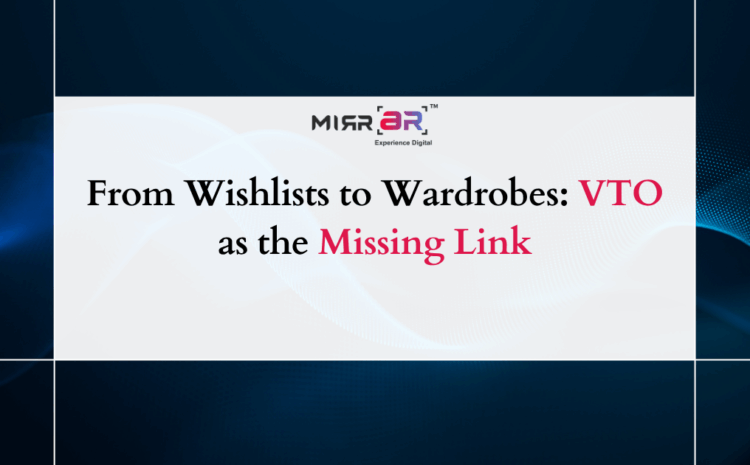In the digital-first world of fashion, one thing remains constant—shoppers love adding items to their wishlists. Whether they’re browsing for inspiration, bookmarking favorite finds, or planning future purchases, online carts and wishlists are a digital version of window shopping. However, there’s often a gap between the wishlist and the wardrobe—between desire and decision. That’s where Virtual Try-On (VTO) technology comes in as the missing link, helping consumers move from browsing to buying with confidence and ease.
The Wishlist Dilemma: Why Shoppers Hesitate
The average online shopper often fills their cart with enthusiasm, only to abandon it later. In fact, studies show that over 70% of online shopping carts are abandoned. For fashion retailers, this represents a massive opportunity—and a major challenge. The key reasons behind this hesitation often include:
- Uncertainty about fit or style
- Lack of confidence in how an item will look
- Fear of making the wrong purchase
- Difficulty visualizing the product in real life
Even the most loyal customers may hold back from buying due to the inability to “try before they buy.” While detailed product photos and size guides help, they don’t offer the personalized assurance that comes from a physical fitting room.
Enter Virtual Try-On: Bridging the Gap
Virtual Try-On (VTO) uses augmented reality (AR) and artificial intelligence (AI) to let shoppers see how products—like clothing, eyewear, accessories, and makeup—look on their body or face in real time. With just a smartphone or webcam, users can visualize the item as if they were standing in front of a mirror.
This technology transforms online shopping into a tactile, interactive experience—providing the same emotional satisfaction as an in-store try-on. With VTO, shoppers can finally close the loop between wishlisting and wardrobe-building.
Why VTO is the Game-Changer for E-Commerce
1. From Passive Browsing to Active Decision-Making
Adding items to a wishlist is passive. It’s a maybe. But trying on that same outfit virtually adds a layer of engagement that pushes the shopper toward a decision. Suddenly, they can see themselves in the item. They’re no longer imagining—it becomes real. This emotional shift is what makes VTO so effective in moving users from contemplation to conversion.
2. Confidence Breeds Conversions
One of the most cited reasons for cart abandonment is the fear of a poor fit. VTO takes the guesswork out by offering a clear visual representation of how an item looks on you—instantly reducing purchase hesitation. The result? Increased buyer confidence, higher conversion rates, and fewer returns.
3. Elevating Personalization
VTO experiences can be customized to reflect individual sizes, skin tones, facial features, or body shapes. This level of personalization doesn’t just improve user satisfaction—it makes them feel understood by the brand. And when customers feel that emotional connection, they’re more likely to hit “buy now” instead of “save for later.”
The Role of Social Sharing and Peer Influence
VTO also taps into a shopper’s desire for social validation. Many platforms now allow users to share their virtual try-ons on social media or within brand communities. This builds trust among peers, encourages user-generated content, and triggers the powerful psychological motivator of FOMO (fear of missing out). When people see their friends trying and buying, they’re more likely to do the same.
Wishlist Integration: Turning Interest into Action
Smart fashion brands are beginning to integrate VTO technology directly into wishlist and cart features. Imagine getting a notification that says, “Your wishlist item is now available to try virtually!” or “See how your saved earrings look on you in real time.”
This seamless blending of VTO and wishlist behavior not only re-engages shoppers but also transforms their dormant interest into active exploration. And with VTO just a click away, the jump from ‘thinking about it’ to ‘owning it’ becomes effortless.
Real-World Success Stories
Several forward-thinking brands have already seen success by merging VTO with their online shopping journey:
- Lenskart integrated VTO for glasses and saw a significant uptick in both engagement and sales. Customers could instantly try on multiple frames, reducing hesitation.
- Nike introduced AR try-ons for sneakers via their app, allowing users to see the shoes on their feet from every angle. This not only boosted conversions but created a share-worthy shopping experience.
- Nykaa offered VTO for makeup products, letting users try lipsticks and eyeshadows before buying—leading to increased customer satisfaction and fewer returns.
These examples highlight how VTO doesn’t just enhance the user experience—it directly impacts the bottom line.
The Future: VTO and Predictive Styling
The next phase of this evolution lies in AI-powered recommendations. Once VTO is integrated with a customer’s wishlist, brands can offer predictive styling—suggesting outfits or accessories based on user preferences, skin tone, body type, or even current wardrobe items. This smart, virtual stylist experience further deepens brand loyalty and boosts average order values.
Conclusion: VTO is More Than a Feature—It’s the Future
In a digital marketplace where customer experience is everything, VTO serves as the much-needed bridge between shopper intent and action. By transforming wishlists into interactive fashion moments, it brings confidence, personalization, and joy back into online shopping.
For brands, embracing VTO means fewer abandoned carts, deeper engagement, and more satisfied customers. For shoppers, it means less guesswork, more style wins, and wardrobes that truly reflect their personality.
Ready to transform your customers’ wishlists into wardrobes?
Explore how MirrAR can bring VTO technology to your fashion brand and elevate the digital shopping journey.
